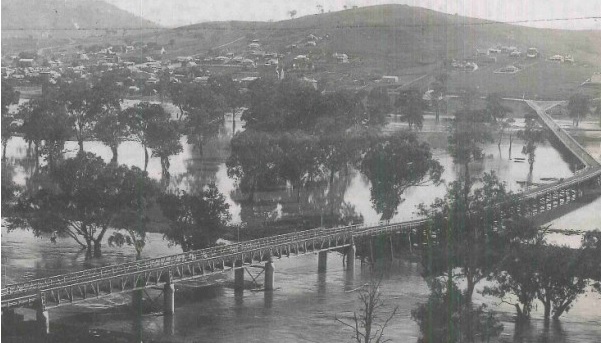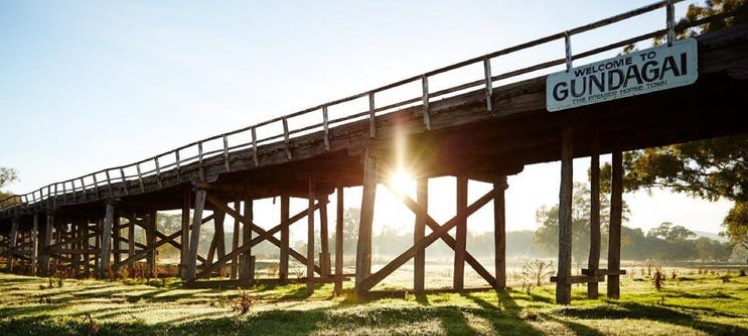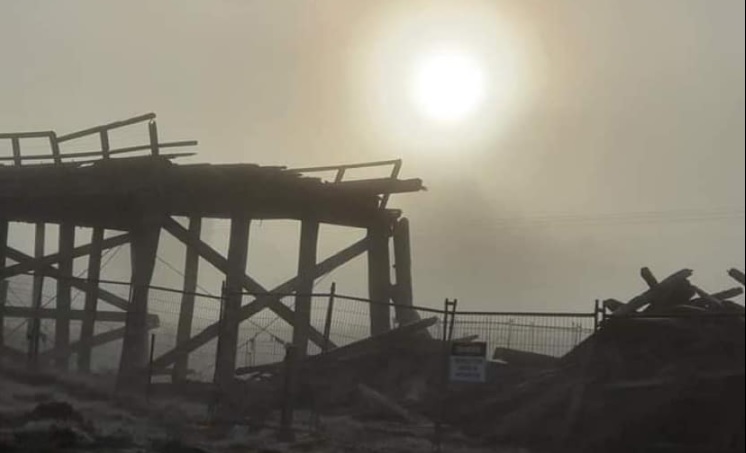
The Gundagai community is stunned the iconic Prince Alfred Bridge has been partially demolished by NSW Crown Lands. Photo: Alan French/Facebook.
It took two days but, crunch, it went – the partial demolition of a 152-year-old timber viaduct that spans the Gundagai floodplain, leaving residents aghast that a section of the heritage-listed tourist attraction could be wrecked without consultation.
None were shocked more than Robert Butcher, who has served on Gundagai’s historic bridges committee for 44 years.
The first he heard of the work was when a passer-by asked him what the heavy machinery was doing there.

Prince Alfred Bridge in its heyday as it spanned the Murrumbidgee River and its surrounding floodplain. Photo: Gundagai Historic Bridges Inc.
In a town where everyone has a story, it’s a time-honoured tradition for visitors to return to Gundagai to share their tale of crossing Prince Alfred Bridge in its glory days.
At 922 metres in length, the bridge and its adjoining hand-hewn timber viaduct enjoyed its status as the longest bridge in NSW, coursing over the mighty Murrumbidgee River and its floodplain for 63 years until surpassed by the Sydney Harbour Bridge .
For 110 years it conveyed Hume Highway traffic, which passed through Gundagai, until a new Sheahan Bridge bypass took on that responsibility in 1977.
Most of all, it did what it was intended to do: survived a century and a half of frequent flooding.
Today, it is as much a part of Gundagai as the Dog on the Tuckerbox, and the town’s 1852 flood heroes, Yarri and Jacky Jacky, have statues erected in their honour.
It remains a monument to the community’s commitment to ensuring the safe passage for trailblazing settlers who arrived at the riverbank in the early days of settlement.
The Prince Alfred Bridge structure was built in the spot explorer Charles Sturt – who in his 1829 search of the great inland sea – deemed safest to cross the Murrumbidgee River, thus setting the path for the passage of the thousands of pioneers on the north-south route linking Victoria and NSW.
As safe as it was, in time the river crossing became a major obstacle for the increasing numbers of travellers. Following the devastating 1852 flood, which claimed 89 lives, regular petitions and deputations were made to the Colonial government for a bridge.
Lack of funds and economic justifications foiled those efforts for 14 years, before the government finally relented and provided £37,000 for the entire river flat to be bridged.

A spectacular latticework of wood, the Prince Alfred Bridge viaduct is an excellent example of early engineering solutions to crossing major flood plains. Photo: Gundagai Historic Bridges Inc.
Constructed between 1864 and 1867, Prince Alfred Bridge was one of the first iron truss bridges to be built in NSW, and the first major bridge crossing spanning the Murrumbidgee River. A short sloping viaduct descended to join the road over the river flats until the long timber viaduct was completed in 1869.
A spectacular latticework of wood, the viaduct was an excellent example of early engineering solutions for crossing major flood plains, their national significance recognised with listing by the National Trust of Australia.
But long has been the battle to preserve it.
Robert recalls back in the late 1970s, soon after Sheahan Bridge opened, there was much talk in the community about preserving Prince Alfred Bridge.
“Back then it was up to the Department of Main Roads to maintain it, but they didn’t because they knew a new bridge was being built,” he says.
Robert says the biggest struggle for the past 40 years has been determining ownership of the structure, and in that time the viaduct has deteriorated to the point where it has closed.
Now in the hands of NSW Crown Lands, the aged and battered treasure is closed to traffic and looking at a $20 million restoration bill.
“We got to a point where we agreed the upper part of the bridge could be removed, leaving the piers and girders and two viewing platforms at either end so people could get an idea of its span and what it looked like,” says Robert.
“I don’t know what’s happening because Crown Lands have knocked down a hell of a lot already, taken out the piers and I don’t know what they have in mind. We haven’t heard back about what they want to do with it.”

Locals believe that now the Prince Alfred Bridge’s integrity has been compromised, the next flood will sweep what remains of it away. Photo: Alan French/Facebook.
A NSW Crown Lands spokesperson said the demolition work has been undertaken on the Oibell Drive spans of Prince Alfred Road Viaduct Bridge after routine engineering assessments identified some deterioration caused by recent heavy rainfall and impact by a truck.
They said work was also required on the Landon Street overpass.
“The department has been liaising with Cootamundra-Gundagai Regional Council, and safety fencing has been placed around the overpass until the community is consulted on the development of a management plan for the bridge,” said the spokesperson.
The confirmed consultations on work occurred through a working group, including representatives from NSW Crown Lands, Cootamundra-Gundagai Regional Council, Gundagai Bridges Heritage Inc, National Trust of Australia, Engineering Australia and the NSW Office of Environment and Heritage.
“Local residents who live in the vicinity of the spans have also been advised about work,” said the spokesperson.
The spokesperson said further community consultations will be held on the development of a management plan for the bridge prior to any further work.
Cootamundra-Gundagai Regional Council Mayor Abb McAlister said the work was undertaken with very little notice to the community.
“They could have let people know within reasonable time before they did it,” he said. “But you know these government bodies that have no attachment to the subject and go in quickly and do it.”
Original Article published by Edwina Mason on About Regional.












